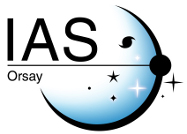Herschel view of the Taurus B211/3 filament and striations: evidence of filamentary growth?
| Titre | Herschel view of the Taurus B211/3 filament and striations: evidence of filamentary growth? |
| Type de publication | Journal Article |
| Year of Publication | 2013 |
| Auteurs | Palmeirim, P, André, P, Kirk, J, Ward-Thompson, D, Arzoumanian, D, Konyves, V, Didelon, P, Schneider, N, Benedettini, M, Bontemps, S, Di Francesco, J, Elia, D, Griffin, M, Hennemann, M, Hill, T, Martin, PG, Men'shchikov, A, Molinari, S, Motte, F, Q. Luong, N, Nutter, D, Peretto, N, Pezzuto, S, Roy, A, Rygl, KLJ, Spinoglio, L, White, GL |
| Journal | Astronomy and Astrophysics |
| Volume | 550 |
| Pagination | 38 |
| Date Published | February 1, 2013 |
| ISBN Number | 0004-6361 |
| Mots-clés | evolution, ISM: clouds, ISM: individual objects: B211, ISM: structure, stars: formation, submillimeter: ISM |
| Résumé | We present first results from the Herschel Gould Belt survey for the B211/L1495 region in the Taurus molecular cloud. Thanks to their high sensitivity and dynamic range, the Herschel images reveal the structure of the dense, star-forming filament B211 with unprecedented detail, along with the presence of striations perpendicular to the filament and generally oriented along the magnetic field direction as traced by optical polarization vectors. Based on the column density and dust temperature maps derived from the Herschel data, we find that the radial density profile of the B211 filament approaches power-law behavior, ρ ∝ r-2.0± 0.4, at large radii and that the temperature profile exhibits a marked drop at small radii. The observed density and temperature profiles of the B211 filament are in good agreement with a theoretical model of a cylindrical filament undergoing gravitational contraction with a polytropic equation of state: P ∝ ργ and T ∝ ργ-1, with γ = 0.97 ± 0.01 < 1 (i.e., not strictly isothermal). The morphology of the column density map, where some of the perpendicular striations are apparently connected to the B211 filament, further suggests that the material may be accreting along the striations onto the main filament. The typical velocities expected for the infalling material in this picture are ~0.5-1 km s-1, which are consistent with the existing kinematical constraints from previous CO observations. Herschel is an ESA space observatory with science instruments provided by European-led Principal Investigator consortia and with important participation from NASA.Figures 1, 7, and Appendices are available in electronic form at http://www.aanda.org |



